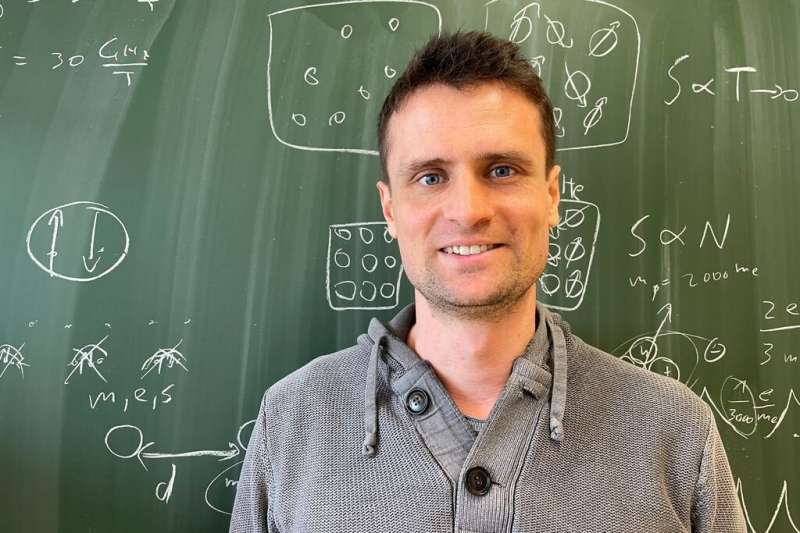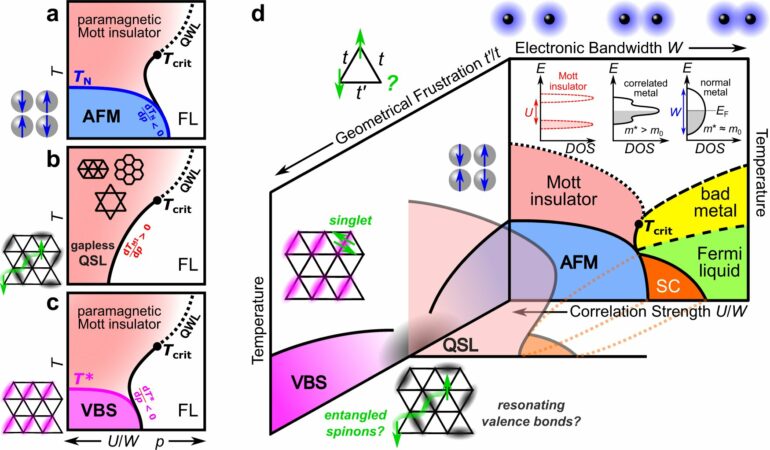For two decades, it was believed that a possible quantum spin liquid was discovered in a synthetically produced material. In this case, it would not follow the laws of classical physics even on a macroscopic level, but rather those of the quantum world. There is great hope in these materials: they would be suitable for applications in quantum entangled information transmission (quantum cryptography) or even quantum computation.
Now, however, researchers from TU Wien and Toho University in Japan have shown that the promising material, κ-(BEDT-TTF)2Cu2(CN)3, is not the predicted quantum spin liquid, but a material that can be described using known concepts.
In their recent publication in the journal Nature Communications, the researchers report how they investigated the mysterious quantum state by measuring the electrical resistance in κ-(BEDT-TTF)2Cu2(CN)3 as a function of temperature and pressure. In 2021, Andrej Pustogow from the Institute of Solid State Physics at TU Wien has already investigated the magnetic properties of this material.
Phase diagrams illustrate material properties
“Phase diagrams are the language of physics,” says Pustogow, leading author of the current study. If you understand this language, a quick glance at the diagram shows how the properties of a material change depending on temperature and pressure. Water, for example, becomes solid at a temperature of 0°C and gaseous at 100°C. If you now change the pressure, for example by heating water in a pressure cooker, the boiling point increases to over 100°C.
In order to now find out how the supposed quantum spin liquid—i.e., a liquid in which the spins of the electrons can rotate freely and are quantum entangled—behaves under pressure, the research team carried out systematic resistance measurements. “The special thing is that the very shape of the phase boundary gives deep insights into the physics of magnetic quantum fluctuations, which actually can’t be measured with electrical resistance per se,” says Pustogow. This was only made possible by a method that is unique worldwide, which the Japanese partners used to study the material. “So we make the impossible possible and follow the entropy footprints of the magnetic moments and thus gain new insights into a supposed quantum spin fluid,” continues Pustogow.

Prof. Andrej Pustogow. © Vienna University of Technology
Disorder as a key
The researchers also found that the phase diagram of κ-(BEDT-TTF)2Cu2(CN)3 strongly resembles that of helium-3. Already back in the 1950s a Soviet researcher predicted that helium-3 behaves differently from conventional materials, turning from solid to liquid rather than from liquid to solid at low temperatures (of less than 0.3 Kelvin). Exactly the same effect occurs with electrons in solids when they freeze upon increasing temperature from a metallic state (mobile electrons) to a Mott insulator, in which the electrons are firmly bound to the atom and do not move.
This “Pomeranchuk effect,” named after the researcher who predicted it, was also observed by the international research team in κ-(BEDT-TTF)2Cu2(CN)3: At higher temperatures, the material initially shows insulating behavior with rigid electrons that melt into a liquid (metal) when it cools. Below 6 Kelvin, however, the electrons freeze again and lose their magnetic moments as well.
“Although κ-(BEDT-TTF)2Cu2(CN)3 itself is not a quantum spin liquid, our research provides important clues for further research into these materials. For example, our experiments help to better understand the mechanism of magnetoelastic coupling. If we succeed in controlling this effect, we may also be able to eventually realize a quantum spin liquid,” Pustogow says.
More information:
A. Pustogow et al, Chasing the spin gap through the phase diagram of a frustrated Mott insulator, Nature Communications (2023). DOI: 10.1038/s41467-023-37491-z
Provided by
Vienna University of Technology
Citation:
The quantum spin liquid that isn’t one (2023, April 18)


